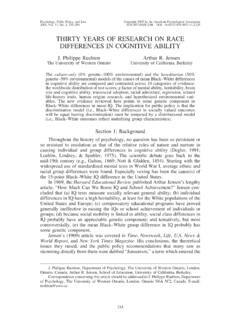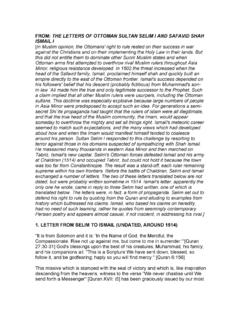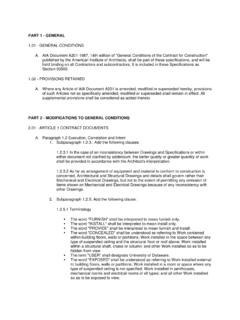Transcription of Chapter 8 Chemical Bonding I: Basic Concepts
1 Chapter 8 Chemical Bonding I: Basic Concepts Copyright McGraw-Hill 20091 Copyright McGraw-Hill 20092 Copyright McGraw-Hill Lewis Dot Symbols Valence electrons determine an element s chemistry. Lewis dot symbolsrepresent the valence electrons of an atom as dots arranged around the atomic symbol. Most useful for main-group elementsCopyright McGraw-Hill 20093 Copyright McGraw-Hill 2009 Lewis Dot Symbols of the Main Group ElementsCopyright McGraw-Hill 20094 Copyright McGraw-Hill 2009 Write Lewis dot symbols for the following:(a)N(b)S2 (c)K+Copyright McGraw-Hill 20095 Copyright McGraw-Hill 2009 Write Lewis dot symbols for the following:(a)N(b)S2 (c)K+K+N S 2 Copyright McGraw-Hill 20096 Copyright McGraw-Hill Ionic BondingNa Cl +Na+Cl +IE1+ EA1= 496 kJ/mol 349 kJ/mol = 147 kJ/mol fH = = 801oC Ionic bond : electrostatic force that holdsoppositely charge particles together Formed between cations and anions ExampleCopyright McGraw-Hill 20097 Microscopic View of NaCl FormationCopyright McGraw-Hill 20098 Copyright McGraw-Hill 2009 NaCl(s) Na+(g)+ Cl (g) Hlattice= +788 kJ/molBecause they are defined as an amountof energy,lattice energies are always positive.
2 +--------+++++++ Lattice energy= the energy required to completely separate one mole of a solid ioniccompound into gaseous ionsCopyright McGraw-Hill 20099 Copyright McGraw-Hill 2009Q = amount of charged = distance of separation dQ1Q2 Coulombic attraction:221dQQF Lattice energy (like a coulombic force) depends on Magnitude of charges Distance between the chargesCopyright McGraw-Hill 200910 Lattice energies of alkali metal iodidesCopyright McGraw-Hill 200911 Copyright McGraw-Hill 2009 The ionic radii sums for LiF and MgO are and , respectively, yet their lattice energies are 1030 and 3795 kJ/mol. Why is the lattice energy of MgO nearly four times that of LiF?Copyright McGraw-Hill 200912 Copyright McGraw-Hill 2009 Born-Haber cycle: A method to determinelattice energiesCopyright McGraw-Hill 200913 Copyright McGraw-Hill 2009 Born-Haber cycle for CaOCa(s)+(1/2)O2(g) CaO(s)Ca(g)#1 #1 Heat of sublimation = Hf [Ca(g)] = +178 kJ/molCa2+(g)#2 #21st & 2nd ionization energies = I1(Ca) + I2(Ca) = + kJ/molO(g)#3 #3(1/2) bond enthalpy = (1/2)D(O=O) = Hf [O(g)]= + kJ/molO2 (g)#4 #41st & 2nd electron affinities = EA1(O) + EA2(O) = +603 kJ/mol+#5#5 (Lattice Energy) = Hlattice[CaO(s)] = (the unknown)#6#6 Standard enthalpy of formation = Hf [CaO(s)] = 635 kJ/mol+178 + + +603 Hlatt= 635 Hlattice= +3398 kJ/molCopyright McGraw-Hill 200914 Copyright McGraw-Hill covalent Bonding Atoms share electrons to form covalentbonds.
3 In forming the bond the atoms achieve a more stable electron configuration. HH + HHH HorCopyright McGraw-Hill 200915 Copyright McGraw-Hill 2009 Octet: Eight is a magic number of electrons. Octet Rule: Atoms will gain, lose, orshare electrons to acquire eightvalence electronsNa Cl +Na+Cl +Examples:H O H O HH++Copyright McGraw-Hill 200916 Copyright McGraw-Hill 2009 Lewis Structures HH + HHH HCl +Cl Cl Cl Cl Cl Shared electrons BondsNon- Bonding valence electrons Lone pairsCopyright McGraw-Hill 200917 Copyright McGraw-Hill 2009 Multiple Bonds-The number of shared electron pairs is the number of Cl Cl Cl Single BondO C O O O =C=Double bond N NN NTriple BondCopyright McGraw-Hill 200918 Copyright McGraw-Hill 2009 bond strength and bond lengthbond strengthsingle < double < triplebond lengthsingle > double > tripleN NN=NN NBond Strength163 kJ/mol418 kJ/mol941 kJ/molBond Copyright McGraw-Hill Electronegativity and Polarity Nonpolar covalent bond = electrons are shared equallyby two bonded atoms Polar covalent bond = electrons are shared unequallyby two bonded atomsCopyright McGraw-Hill 200920red high electron densitygreen intermediate electron
4 Densityblue low electron density Electron density distributions + -H F alternaterepresentationsH FCopyright McGraw-Hill 200921 Copyright McGraw-Hill 2009 Electronegativity: ability of an atom to draw shared electrons to electronegative elements attract electrons more strongly. relative scale related to IEand EA unitless smallest electronegativity: Cs largest electronegativity: F Copyright McGraw-Hill 200922 Copyright McGraw-Hill 2009 Electronegativity: The Pauling ScaleCopyright McGraw-Hill 200923 Copyright McGraw-Hill 2009 Variation in Electronegativity with Atomic NumberCopyright McGraw-Hill 200924 Copyright McGraw-Hill 2009 Polar and nonpolar = = = > is ionicCopyright McGraw-Hill 200925 Copyright McGraw-Hill 2009 Dipole moments and partial charges-Polar bonds oftenresult in polar polar molecule possesses a moment ( )= the quantitative measure of a dipole = Qr r+Q Q + -H F SI unit: coulomb meter (C m)common unit: debye (D)1D = 10 30C DCopyright McGraw-Hill 200926 Copyright McGraw-Hill Drawing Lewis Structures1)Draw skeletal structure with the central atom being the least electronegative )Sum the valence electrons.
5 Add 1 electron for each negative charge and subtract 1 electron for each positive )Subtract 2 electrons for each bond in the skeletal )Complete electron octets for atoms bonded to the central atom except for ) Place extra electrons on the central ) Add multiple bonds if atoms lack an McGraw-Hill 200927 Copyright McGraw-Hill 2009 What is the Lewis structure of NO3 ?1)Draw skeletal structure with central atom being the least N O 4)Complete electron octets for atoms bonded to the central atom except for hydrogen.:O::O N O: :::::18e 6)Add multiple bonds if atoms lack an octet.:O::O N= O: ::::24e 5)Place extra electrons on the central )Sum valence electrons. Add 1 for each negative charge and subtract 1 for each positive (1 5) + (3 6) + 1 = 24 valence e 24e 3) Subtract 2 for each bond in the skeletal structure. 6 e Copyright McGraw-Hill 200928 Copyright McGraw-Hill 2009 Copyright McGraw-Hill 200929 Copyright McGraw-Hill Lewis Structures and Formal Charge The electron surplus or deficit, relative to the free atom, that is assigned to an atom in a Lewis charges are not real :orig.
6 Valence e = 1 non- Bonding e = 0 1/2 Bonding e = 1formal charge= 0O:orig. valence e = 6 non- Bonding e = 4 1/2 Bonding e = 2formal charge= 0 Example:H2O =H:O:H::Total valence electronsFormal Charge=Total non- Bonding electrons Total Bonding electrons112 Copyright McGraw-Hill 200930 Copyright McGraw-Hill 2009 Example: Formal charges on the atoms in ozone 6 4 124 0 6 2 126 1 6 6 122 1 OOOOOOC opyright McGraw-Hill 200931 Copyright McGraw-Hill 2009 Formal charge guidelines A Lewis structure with noformal charges is generally better than one with formal charges. Small formal charges are generally better than large formal charges. Negative formal charges should be on the more electronegative atom(s).Example:Answer:or?H C O HC OHHH C O H +C OHH Copyright McGraw-Hill 200932 Copyright McGraw-Hill 2009 Identify the best structure for the isocyanate ion below:(a):C = N = O: :C N O: (c)(b):C N O: 2+1 3+1+1+1 1 10 Copyright McGraw-Hill 200933 Copyright McGraw-Hill 200933 Copyright McGraw-Hill 2009 Identify the best structure for the isocyanate ion below:(a):C = N = O: :C N O: (c)(b):C N O: 2+1 3+1+1+1 1 10 Copyright McGraw-Hill 200934 Copyright McGraw-Hill ResonanceTwo resonance structures, their average or the resonance hybrid, best describes the nitrite ion.
7 :O N= O::::: :O = N O::::: Solution:The double-headed arrow indicates resonance.:O N= O::::: These two bonds are known to be identical. Resonance structures are used when two or more equally valid Lewis structures can be : NO2 Copyright McGraw-Hill 200935 Copyright McGraw-Hill 2009 Benzene: C6H6 Additional ExamplesCarbonate: CO32 orCopyright McGraw-Hill 200936 Copyright McGraw-Hill Exceptions to the Octet Rule Exceptions to the octet rule fall into three categories: Molecules with an incomplete octet Molecules with an odd number of electrons Molecules with an expanded octetCopyright McGraw-Hill 200937 Copyright McGraw-Hill 2009 Incomplete OctetsExample: BF3 (boron trifluoride)BF3 (1 3) + (3 7) = 24 val. e :F::F B = F: ::::+1-1 Common with Be, B and Al compounds, but they often dimerize or :ClClClBe Be Be BeClClCl:F::F B F: :::::no octetCopyright McGraw-Hill 200938 Copyright McGraw-Hill 2009 Odd Numbers of ElectronsExample: NO (nitrogen monoxide or nitric oxide)NO (1 5) + (1 6) = 11 valence e Example: NO2(nitrogen dioxide)NO2 (1 5) + (2 6) = 17 val.
8 E :N=O:.:N=O:.Are these both equally good? :O=N O:.:O N=O:.:O=N O:.:O N=O:.Are these all equally good? better00 1+10000000+1 1 1+10bestCopyright McGraw-Hill 200939 Copyright McGraw-Hill 2009 Expanded Octet Elements of the 3rd period and beyond have d-orbitals that allow more than 8 valence :F Xe F::::::(Xe has 10 valenceelectrons)22 valence e (S has 12 valenceelectrons)FFSFF:F: :F:SF6 =48 valence e Copyright McGraw-Hill 200940 Copyright McGraw-Hill bond Enthalpy bond enthalpy is the energy associated with breaking aparticular bond in one mole of gaseous (g) H(g) + Cl(g) Ho= kJCl2(g) Cl(g) + Cl(g) Ho= kJO2(g) O(g) + O(g) Ho= kJN2(g) N(g) + N(g) Ho= kJsingle bondsdouble bondtriple bond For diatomic molecules these are accuratelymeasured quantities. bond enthalpy is one measure of molecular stability. Symbol: HoCopyright McGraw-Hill 200941 Copyright McGraw-Hill 2009 bond enthalpies for polyatomic molecules depend upon the bond s environment.
9 Average bond enthalpies are used for polyatomic molecules. Provide only estimates H= 435 kJHH C HH HH CH + H H= 410 kJ6% less + HHH CH H C HH HH CH H CH Copyright McGraw-Hill 200942 Copyright McGraw-Hill 2009 Prediction of bond enthalpyreactantsatomsproductsBE(r) BE(p)enthalpy Ho= BE(reactants) BE(products)Copyright McGraw-Hill 200943 Copyright McGraw-Hill 2009 Example: Calculate the enthalpy of reaction forCH4(g)+ Br2(g) CH3Br(g)+ HBr(g)Solution:Consider ONLY bonds broken or C HH Br BrH Br++HH C BrH Hrxn= [BE(C H) + BE(Br Br)] [BE(C Br) + BE(H Br)]= [(413) + (193)] [(276) + (366)]= 36 kJ/molCopyright McGraw-Hill 200944 Copyright McGraw-Hill 2009 Copyright McGraw-Hill 200945 Key Points Lewis dot symbols Ionic Bonding Lattice energy Born-Haber cycle covalent Bonding Octet rule Lewis structures bond order bond polarityCopyright McGraw-Hill 200946 Key Points Electronegativity Dipole moment Drawing lewis structures Formal charge Resonance structures Incomplete octets Odd numbers of electrons Expanded octets bond enthalpy



















